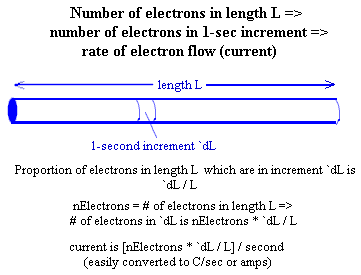
Problem: If a .9000 meter length of uniform conducting wire contains 378200000000 current-carrying electrons, then if the electrons drift along the wire at .006000 m/s, how many electrons per second pass a given point on the wire? What then is the current in amps?
.
.
.
.
.
.
.
.
.
.
.
.
.
.
.
.
.
.
.
.
.
.
.
.
.
.
.
.
.
.
Solution: Since electrons drift at .006000 m/s, in 1 second all the electrons in .006000 meters of the wire will pass a given point.
The length increment .006000 meters is .006000 / .9000 = .006666of the length of the wire.
This increment therefore contains .006666 * 378200000000 = 2.56 * 10^9 electrons.
So in a second, the rate at which electrons pass the point is 2.56 * 10^9 electrons.
Generalized Response: If there are nElectrons current-carrying electrons in a length L of wire, and if they drift a distance `dL in one second, then in each second the proportion `dL / L of the nElectrons electrons, or (nElectrons * `dl / L) electrons will pass a given point. The electrons each carry charge 1.6 * 10^-19 Coulombs, so the current is
1.6 * 10 ^ -19 Coulombs / electron * (nElectrons * `dL / L) electrons / sec = 1.6 * 10^-19 * nElectrons * `dL / L amps.
.
.
.
.
.
.
.
.
.
.
Figure description: The figure below shows a length L of wire containing nElectrons current-carrying electrons, and a segment of length `dL through which electrons travel in a second. The segment contains `dL / L of the total number of electrons (in this picture `dL / L appears to be perhaps 1/20, so 1/20 of the total number of electrons are contained in the segment). Thus the segment contains nElectrons * `dL / L electrons, and this is the number of electrons flowing past a given point per second. The resulting current in electrons/second is easily converted to Coulombs/second.